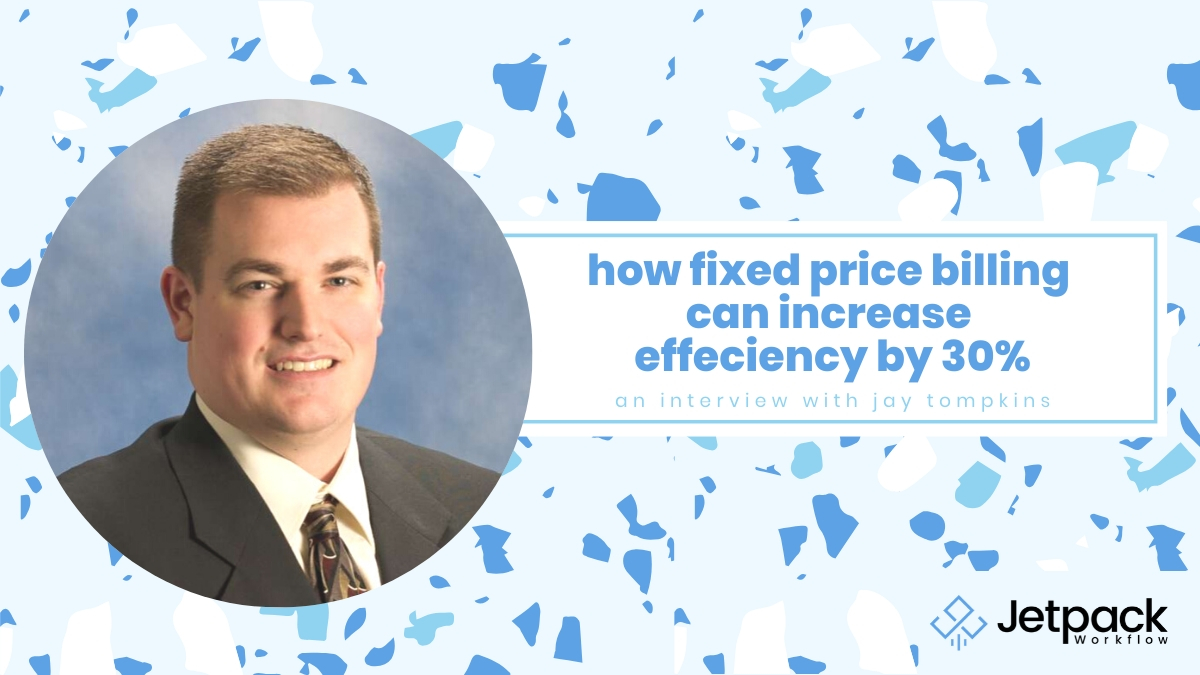How Fixed Price Billing Can Increase Effeciency by 30%

Jay Tompkins, Partner-in-Charge at MRZ CPAs, successfully implemented fixed price billing in his firm which increased efficiency 30%.
Jay recognizes the trend to move towards value pricing. For many firms, it’s a daunting task to make a complete switch. He reveals: Most firms already implement a hybrid fixed price billing system, they just don’t discuss it with their clients.
Jay will show you the steps to start increasing efficiency and profit in your firm through fixed pricing.
In this episode of Growing Your Firm Podcast, David Cristello and Jay Tompkins reveal:
- Why the client doesn’t understand the “billable hour” and how it harms you.
- The benefits of fixed price billing over the billable hour.
- How to avoid those “awkward” billing questions from your clients.
- MRZ CPAs – Jay’s Firm
- Jay’s Linkedin Profile
- Delivering Value Driven Service and Pricing – Ed Kless (interview)
- Going into the Value Based Billing – Jason Blumer (interview)
The unprecedented growth of a firm in 3 years:
MRZ CPAs started just 3.5 years ago in late December 2012. As of 2016, they have 2 offices and working on a third, and 100 staff. How it started was a group of 18 CPAs worked under the banner of another CPA firm before splitting out and starting MRZ. Since then, the firm grew simply through organic methods.
The secret? Jay Tompkins says simply: “Being better with our communication and pricing.”
A group of CPAs branching out from a larger firm is an unprecedented move, but it’s worked for MRZ. It’s worked because the group of 18 were a strong, cohesive group.
They also had built a solid book of business who spun-off to the new firm with them.
Since Jay started with the firm, he’s managed to flip his branch from the billable hour to fixed price billing. From this, he’s increased profits, built a happier client base, and boosted efficiency by 30%.
How did he do it? First. Jay dug into the problems with the billable hour.
The problem with the billable hour:
In the compliance business, Jay believes it can be tough to directly switch over to value pricing. Unlike any sort of marketing or sales goals, compliance goals are harder to measure the monetary value. He’s seen many firms actually use a hybrid model of fixed pricing.
For many firms, they record their time. Then, when it comes to billing, they look at the time spent and compare it to what was billed the prior year. After which, they mark it up or down to get close to the prior year.
Weeks, even months, after the work is done, the bill gets sent out. Now, administrative tasks, especially bill collecting, are added to your plate.
What you need to understand is your client doesn’t understand the billable hour. When you write up or down your time and bill it, your client believes they are on a fixed price already. A true billable hour only brings conflict.
DAVID’S TIP: Billing by the hour drives my anxiety. If I drop my car off and the mechanic says, “It will be $85 an hour to fix your car. Talk later.” I feel neglected and worried about what’s going to happen.
When you bill too much to a client, they get upset. If you bill too low, you set the expectations for lower bills. On top of that, when the project goes out of scope, a client then gets billed more than what they thought the project would cost. Clients don’t like being surprised.
Making the conversion to fixed price billing:
The easiest step to start your venture into fixed price billing is working on price upfront with the customer. A typical firm gets a new client, looks at their prior year tax return, and then ushers the client out. Discuss with the client the different things they remember the last CPA needed. What problems and snags came up?
What did the client not like?
Doing this allows you to narrow down the scope to then provide a pricing structure. Narrowing the scope then gives you the option to add additional services to the scope for increased cost.
“Just because the industry has done it this way forever, doesn’t mean you have to do it.”
– Jay Tompkins
Jay found most clients will pay more for the predictability of fixed pricing. Again, it boils down to the conversation you have upfront with the client. Your client wants it to be simple for them to understand. Add on top, you can bill them each month by taking the full price of the engagement and dividing by 12. Now, you’ve built predictability of revenue into your business.
This is unlike most firms where you bill it all at once, then the client waits 6 months to pay thus bringing cashflow problems into the firm.
These conversations upfront make it easy to come back to the client and say, “We are going to need to add on additional services. If we do it, it’s $X, or you can do it.”
Most of the time, the client will just pay the extra for you to do it. Having the payments spread out over months makes it predictable payments for them as well.
Now, you’ve removed Accounts Receivable and the awkward conversations explaining to clients why their bill was what it was.
Closing ideas:
Jay believes making this transition is all a mindset. Realize your firm can be better and more profitable. Have the mindset of wanting to make it easier for your client and they will pay an added premium for this.
Discuss internally on the best ways to make the switch and get everyone on board. Next, figure out — Who should we begin switching to fixed? It’s easiest to do so with new clients. There aren’t any preconceived notions.
The best time to roll out to old clients is around Fall. When you send out next year’s engagement letters, open the conversation to these clients. Older clients require a more “long sit-down” approach. You could lose a small percentage of clients making the switch, but remember, it’s for the good of the firm.
This firm will continue to accelerate growth due to implementing these new ways to run the firm. Where do you want your firm to go?
Related Articles:






